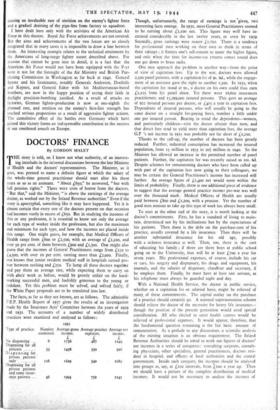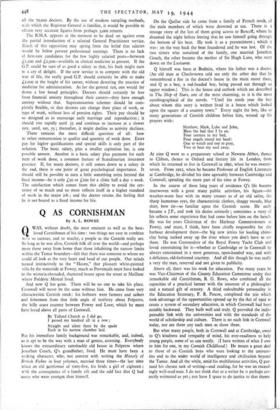DOCTORS' FINANCE
By GORDON MALET
THE story is told, on I know not what authority, of an interest- ing interlude in the informal discussions between the late Minister of Health and the doctors' representatives. The Minister, so it goes, was pressed to name a definite figure at which the salary of the whole-time general practitioner should start after his three years or so as an assistant. " About £650," he answered, " but with full pension rights." There were cries of horror from the doctors. " But that," said the Minister, " is above the earnings of the average doctor, as worked out by the Inland Revenue authorities." Even if the story is apocryphal, something like it may have happened. Yet it is almost certain that every one of the doctors present on that occasion had incomes vastly in excess of £65o. But in studying the incomes of this or any profession, it is essential to know not only the average for each type of worker inside the profession, but also the maximum and minimum for each type, and how the incomes are placed inside this range. One might guess, for example, that Medical Officers of Health range from L600 to L2,500, with an average of £1,200, and over 5o per cent of them between £900 and k1,300. One might also guess that the incomes of General Practitioners range from L25o to 4,5oo, with over to per cent. earning more than £2,000. Finally, one knows that junior resident medical staff in hospitals earned pre- war between nothing and £250. To lump all these doctors together and pay them an average rate, while expecting them to carry on with .their work as before, would be grossly unfair on the hard- working successful men, and foolishly generous to the young or indolent. Yet this problem must be solved, and salved fairly, if the White Paper proposals are to be translated into law.
The facts, as far as they are known, are as follows. The admirable Y.E.P. Health Report of 1937 gives the results of an investigation made by the Insurance Acts' Committee between the years of 1929 and 1931. The accounts of a number of widely distributed practices were examined and analysed as follows:
193x
Type of praCtice. Number Average gross Average practice Average net
examined. income. expenses. income.
£ £ £ No dispensing ...
6
1736 487
1249 Dispensing for all patients 35 1456 530 926 Dispensing for private patients only.., ro8 1629 540 1089
Dispensing for all
private patients and some insur- ance patients 46
752 1242 Though, unfortunately, the range of earnings is not 'given, two interesting facts emerge. In 1931, most General Practitioners seemed to be earning about Li,too net. This figure may well have in- creased considerably in the last twelve years, or even by 1939. Secondly, gross earnings were nearer £1,7oo. There is a tendency for professional men working on their own to think in terms of their takings ; it flatters one's self-esteem to name the higher figure, and only when the time for income-tax returns comes round does one get down to brass tacks.
One may approach the problem in another way—from the point of view of capitation fees. Up to the war, doctors were allowed 2,500 panel patients, with a capitation fee of 9s. 6d., while the engage- ment of an assistant gave the right to another 1,500. In 1935, when the capitation fee stood at 9s., a doctor on his own could thus earn £1,1/25 from his panel alone. Yet there were 16,600 insurances practitioners and 15,299,000 insured persons. This gave an average of 922 insured persons per doctor, or £415 a year in capitation fees. Dependents of insured persons, who will usually be going to the same doctor on a straight fee-paying basis, number a little under one per insured person. Bearing in mind the dependents—women, and particularly children—visit the doctor oftener than men, and that direct fees tend to yield more than capitation fees, the average G.P 's net income in 1935 was probably not far short of £1,200.
Thanks to the call-up, the number of doctors has been greatly reduced. Further, industrial conscription has increased the insured population, from x5 million in 1935 to 20} million in 194o. So the Minister has allowed an increase in the permitted number of panel patients. Further, the capitation fee was recently raised to nos. 6d. Despite schemes for remunerating doctors who have been called up with part of the capitation fees now going to their colleagues, we may be certain the General Practitioner's income has increased still further. An average figure of £T,400 net would seem within the limits of probability. Finally, there is one additional piece of evidence to suggest that the average general practice income pre-war was well over the thousand mark. Medical Officers of Health are usually paid between C800 and £r,zoo, with a pension. Yet the number of good men anxious to take up this type of work has always been small.
To start at the other end of the story, it is worth looking at the doctor's commitments. First, he has a standard of living to main- tain, determined not by his inclinations but by the expectations of his patients. Then there is the debt on the purchase-cost of his practice, usually covered by a life insurance. Then there will be another substantial insurance for his old age, possibly with a sickness insurance as well. Then, too, there is the cost of educating his family ; if there are three boys at public school going on to the University, that will be at least k7oo a year for seven years. His professional expenses, of course, include his car or cars, his surgery and dispensary, his drugs and equipment, his journals, and the salaries of dispenser, chauffeur and secretary, if he employs them. Finally, he must have at least one servant, as his telephone must always be guarded night and day.
With a National Health Service, the doctor in public service, whether on a capitation fee or salaried basis, might be relieved of many_ of these commitments. The capital outlay on the purchase of a practice should certainly go. A national superannuation scheme should relieve the doctor of the necessity for heavy life insurance— though the position of the present generation would need special consideration. All who elected to enter health centres would be relieved of professional expenses. It would appear, therefore, that the fundamental question remaining is the fair basic amount of remuneration. As a prelude to any discussions, a scientific analysis of the existing situation is an obvious requirement. The Inland Revenue Authorities should be asked to work out figures of doctors' net incomes in a series of categories: consulting surgeons, consult- ing physicians, other specialists, general practitioners, doctors resi- dent' in hospital, and officers of local authorities and the central government. Inside each category, the incomes should be analysed into groups at, say, at Lux) intervals, from Lioo a year up. Thus we should have a picture of the complete distribution of medical incomes. It would not be necessary to analyse' the incomes of all the 70,000 doctors. By the use of modem sampling methods, with which the Registrar General is familiar, it would be possible to obtain very accurate figures from perhaps 5,000 returns.
The B.M.A. appears at the moment to be dead set against even the partial introduction of a salaried General Practitioner service. Much of this opposition may spring from the belief that salaries would be below present professional earnings. , There is no lack of first-rate candidates for the few highly salaried posts—between £1,200 and £2,500—available in clinical medicine at present. If the G.P. could be sure of as good a salary as that, his bark might turn to a cry of delight. If the new service is to compare with the old way of life, the really good G.P. should certainly be able to make £2,000 at the height of his career, without deserting the practice of medicine for administration. As for the general run, one would lay down a few broad principles. Doctors should certainly be free from financial anxiety throughout their careers—they have enough anxiety without that. Superannuation schemes should be com- pletely flexible, so that doctors can change their place of work, or type of work, without loss of pension rights. Their pay should be so designed as to encourage early marriage and reproduction ; it should rise rapidly until 35 and continue to increase at a slower rate, until, say, 55 ; thereafter, it might decline as activity declines.
There remains the most difficult question of all : how to relate remuneration to quality and quantity of work done. Extra pay for higher qualifications and special skills is only part of the solution. The basic salary, plus a smaller capitation fee, is one possible answer. Another is a basic salary plus payment for each item of work done, a common feature of Scandinavian insurance practice. If, for many doctors, it still comes down to a salary in the end, there is one point of great psychological importance. It should still be possible to earn a little something extra beyond the fixed income—be it only £50 or Doc) for a clinic half a day a week. The satisfaction which comes from this ability to avoid the cer- tainty of so much and no more reflects itself in a higher standard of work in the major job ; and the doctor retains the feeling that he is not bound to- a fixed income for life.



























 Previous page
Previous page